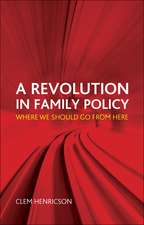Transitions to Parenthood in Europe: A Comparative Life Course Perspective
Editat de Ann Nilsen, Julia Brannen, Suzan Lewisen Limba Engleză Hardback – 17 apr 2012
Transitions to Parenthood in Europe analyzes and compares the biographies of mothers and fathers in seven European countries. Focusing on how working people negotiate the transition into parenthood—and the work-life balances it requires—the contributors provide an in-depth understanding of working parents’ real lives within a diverse set of national, workplace, and family contexts. With rich insights into how institutional policy and practices affect individuals and families, it highlights pertinent and sometimes challenging issues regarding the sustainability of contemporary lifestyles as people try to create a healthy, supportive home.
Preț: 826.75 lei
Preț vechi: 1073.70 lei
-23% Nou
Puncte Express: 1240
Preț estimativ în valută:
158.19€ • 165.18$ • 130.63£
158.19€ • 165.18$ • 130.63£
Carte tipărită la comandă
Livrare economică 16-30 aprilie
Preluare comenzi: 021 569.72.76
Specificații
ISBN-13: 9781847428646
ISBN-10: 1847428649
Pagini: 166
Ilustrații: 15 figures, 6 tables
Dimensiuni: 152 x 229 x 33 mm
Greutate: 0.41 kg
Ediția:New.
Editura: Bristol University Press
Colecția Policy Press
ISBN-10: 1847428649
Pagini: 166
Ilustrații: 15 figures, 6 tables
Dimensiuni: 152 x 229 x 33 mm
Greutate: 0.41 kg
Ediția:New.
Editura: Bristol University Press
Colecția Policy Press
Notă biografică
Ann Nilsen is professor of sociology at the University of Bergen in Norway. Julia Brannen is professor of sociology of the family at the Thomas Coram Research Unit at the Institute of Education.Suzan Lewis is professor of organizational psychology in the department of Human Resource Management at Middlesex University Business School.
Cuprins
List of tables and figures
Notes on contributors
Acknowledgements
1. Introduction
Ann Nilsen, Julia Brannen and Suzan Lewis
2. Cross-national comparisons: the history–biography link
Ann Nilsen
3. Methodological approaches, practices and reflections
Julia Brannen and Ann Nilsen
4. Comparing transitions to motherhood across contexts
Ann Nilsen, Maria das Dores Guerreiro, Siyka Kovacheva and Janet Smithson
5. Comparing transitions to fatherhood across contexts
Lars Plantin, Margareta Bäck-Wiklund, Siyka Kovacheva and Maria das Dores Guerreiro
6. Supports and constraints for parents: a gendered cross-national perspective
Janet Smithson, Suzan Lewis, Siyka Kovacheva, Laura den Dulk, Bram Peper and Anneke van Doorne-Huiskes
7. Being a working parent in the present: case comparisons in time and place
Julia Brannen and Nevenka Sadar Cernigoj
8. Conclusions
Suzan Lewis, Ann Nilsen and Julia Brannen
References
Index
Notes on contributors
Acknowledgements
1. Introduction
Ann Nilsen, Julia Brannen and Suzan Lewis
2. Cross-national comparisons: the history–biography link
Ann Nilsen
3. Methodological approaches, practices and reflections
Julia Brannen and Ann Nilsen
4. Comparing transitions to motherhood across contexts
Ann Nilsen, Maria das Dores Guerreiro, Siyka Kovacheva and Janet Smithson
5. Comparing transitions to fatherhood across contexts
Lars Plantin, Margareta Bäck-Wiklund, Siyka Kovacheva and Maria das Dores Guerreiro
6. Supports and constraints for parents: a gendered cross-national perspective
Janet Smithson, Suzan Lewis, Siyka Kovacheva, Laura den Dulk, Bram Peper and Anneke van Doorne-Huiskes
7. Being a working parent in the present: case comparisons in time and place
Julia Brannen and Nevenka Sadar Cernigoj
8. Conclusions
Suzan Lewis, Ann Nilsen and Julia Brannen
References
Index
Recenzii
"This collaborative study provides a subtle and multi-layered understanding of the transition to parenthood within a cross-national comparative framework. Here is a study which is heartily recommended not only to researchers and students of family and social policy but also to those interested in the practice and promise of comparative analysis."
“very insightful . . . crucial to understanding the phenomenon of working parenthood . . . underlines the potential positive effects of the economic downturn.”










